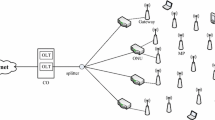Abstract
Energy savings in Internet have been regarded as a significant technical issue for academic and industrial community. Particularly, access network accounts for more than 70% of the total energy consumption of Internet. As a promising access technique, Fiber-Wireless (FiWi) network not only enables the cost-effective broadband access, but also provides more opportunities for energy savings. Previous works mostly focused on the energy savings in the optical back-end of FiWi. Generally, they extended the Optical Network Unit (ONU) sleep mechanisms initially designed for Passive Optical Network (PON) to FiWi by combining with the wireless rerouting. However, most of these works left the energy savings in the wireless front-end untouched. In fact, when one or more ONUs in the network is/are sleeping, many wireless components remain idle or underutilized which cause a lot of energy waste. Motivated by this, we propose a new integrated Wireless-Optical Energy Savings (WOES) scheme for the comprehensive energy savings in FiWi. The WOES scheme consists of two interactive modules, Energy-Efficient ONU Management (EEOM) and Energy-Aware Topology Configuration (EATC). EEOM aims at the energy savings in the optical back-end by putting the low-load ONUs into sleep state. A pair of thresholds is introduced into EEOM to maintain the states of ONUs. As soon as ONUs states change, EATC will reconfigure the wireless topology by putting the idle Radio Interfaces (RIs) into standby state, thus minimizing the energy consumption of the wireless front-end. Simulation results show that the WOES scheme can reduce the energy consumption significantly with just a little performance degradation in network throughput and end-to-end delay.
Similar content being viewed by others
References
Valcarenghi L, van D P, Raponi P G, et al. Energy efficiency in passive optical networks: where, when, and how. IEEE Netw, 2012, 26: 61–68
Schutz G, Correia N. Design of QoS-aware energy-efficient fiber-wireless access networks. IEEE/OSA J Optical Commun Netw, 2012, 4: 586–594
Du S, Zhang S, Peng Y, et al. Power-efficient RWA in dynamic WDM optical networks considering different connection holding times. Sci China Inf Sci, 2013, 56: 042306
Huang S, Li B, Guo B, et al. Distributed protocol for removal of loop backs with asymmetric digraph using GMPLS in p-cycle based optical networks. IEEE Trans Commun, 2011, 59: 541–551
Jiang D, Hu G. GARCH model-based large-scale IP traffic matrix estimation. IEEE Commun Lett, 2009, 13: 52–54
Zhang Z, Jiang W, Zhou H, et al. High accuracy frequency offset correction with adjustable acquisition range in OFDM systems. IEEE Trans Wirel Commun, 2005, 4: 228–237
Reaz A, Ramamurthi V, Tornatore M, et al. Cost-efficient design for higher capacity hybrid wireless-optical broadband access network (WOBAN). Comput Netw, 2011, 55: 2138–2149
Reaz A, Ramamurthi V, Sarkar S, et al. CaDAR: an efficient routing algorithm for a wireless-optical broadband access network (WOBAN). IEEE/OSA J Opt Commun Netw, 2009, 1: 392–403
Sarkar S, Dixit S, Mukherjee B. Hybrid wireless-optical broadband-access network(WOBAN): a review of relevant challenges. IEEE/ACM Trans Netw, 2007, 25: 3329–3339
Lee K, Sedighi B, Tucker R S. Energy efficiency of optical transceivers in fiber access networks. IEEE/OSA J Opt Commun Netw, 2012, 4: A59–A68
Sankaran G C, Sivalingam K M. ONU buffer elimination for power savings in passive optical networks. In: Proceedings of IEEE International Conference on Communications, Kyoto, 2011. 1–5
Yan Y, Wong S, Valcarenghi L, et al. Energy management mechanism for ethernet passive optical networks (EPONs). In: Proceedings of IEEE International Conference on Communications, Cape Town, 2010. 1–5
Shi L, Mukherjee B, Lee S S. Energy-efficient PON with sleep-mode ONU: progress, challenges, and solutions. IEEE Netw, 2012, 26: 36–41
Zhang J, Ansari N. Toward energy-efficient and 10G-EPON with sleep-aware 1G-EPON MAC control and scheduling. IEEE Commun Mag, 2011, 49: s33–s38
Chowdhury P, Tornatore M, Sarkar S, et al. Building a green wireless-optical broadband access network (WOBAN). IEEE/OSA J Lightwave Technol, 2010, 28: 2219–2229
Kantarci B, Mouftah H T. Energy efficiency in the extended-reach fiber-wireless access networks. IEEE Network, 2012, 6: 28–35
Liu X, Ghazisaidi N, Ivanescu L, et al. On the tradeoff between energy saving and QoS support for video delivery in EEE-based FiWi networks using real-world traffic traces. IEEE/OSA J Lightwave Technol, 2011, 29: 2670–2676
Kazovsky L G, Ayhan T, Ribeiro M R N, et al. Energy efficient optical-wireless residential access/in-house networks. In: Proceedings of International Conference on Transparent Optical Networks (ICTON), Stockholm, 2011. 1–4
Chieochan S, Hossain E. Channel assignment for throughput optimization in multichannel multiradio wireless mesh networks using network coding. IEEE Trans Mobile Comput, 2013, 12: 118–135
Zhang Z, Long K, Zhao M, et al. Joint frame synchronization and frequency offset estimation in OFDM systems. IEEE Trans Broadcast, 2005, 51: 389–394
Lin T, Hsieh K, Huang H. Applying genetic algorithms for multiradio wireless mesh network planning. IEEE Trans Veh Technol, 2012, 61: 2256–2270
Huang S, Lian W, Zhang X, et al. A novel method to evaluate clustering algorithms for hierarchical optical networks. Photonic Netw Commun, 2012, 23: 183–190
Monoyios D, Vlachos K. Multiobjective genetic algorithms for solving the impairment-aware routing and wavelength assignment problem. IEEE/OSA J Opt Commun Netw, 2011, 3: 40–47
Liu T, Liao W. Interplay of network topology and channel assignment in multi-radio multi-rate multi-channel wireless mesh networks. In: Proceedings of IEEE Global Telecommunications Conference, New Orleans, 2008. 1–5
Author information
Authors and Affiliations
Corresponding author
Rights and permissions
About this article
Cite this article
Liu, Y., Guo, L., Zhang, L. et al. A new integrated energy-saving scheme in green Fiber-Wireless (FiWi) access network. Sci. China Inf. Sci. 57, 1–15 (2014). https://doi.org/10.1007/s11432-013-4958-7
Received:
Accepted:
Published:
Issue Date:
DOI: https://doi.org/10.1007/s11432-013-4958-7




